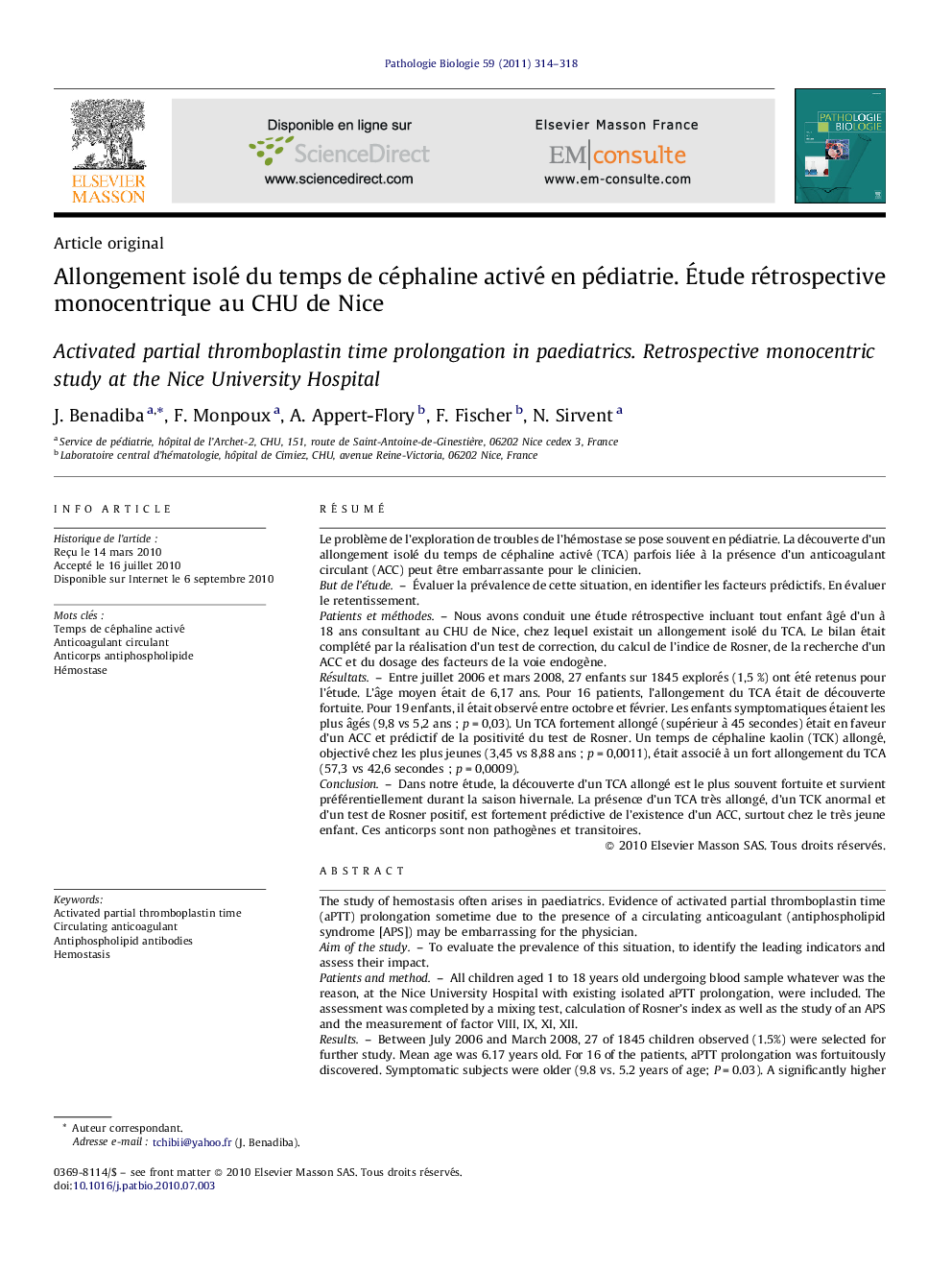| کد مقاله | کد نشریه | سال انتشار | مقاله انگلیسی | نسخه تمام متن |
|---|---|---|---|---|
| 4136190 | 1271901 | 2011 | 5 صفحه PDF | دانلود رایگان |

RésuméLe problème de l’exploration de troubles de l’hémostase se pose souvent en pédiatrie. La découverte d’un allongement isolé du temps de céphaline activé (TCA) parfois liée à la présence d’un anticoagulant circulant (ACC) peut être embarrassante pour le clinicien.But de l’étudeÉvaluer la prévalence de cette situation, en identifier les facteurs prédictifs. En évaluer le retentissement.Patients et méthodesNous avons conduit une étude rétrospective incluant tout enfant âgé d’un à 18 ans consultant au CHU de Nice, chez lequel existait un allongement isolé du TCA. Le bilan était complété par la réalisation d’un test de correction, du calcul de l’indice de Rosner, de la recherche d’un ACC et du dosage des facteurs de la voie endogène.RésultatsEntre juillet 2006 et mars 2008, 27 enfants sur 1845 explorés (1,5 %) ont été retenus pour l’étude. L’âge moyen était de 6,17 ans. Pour 16 patients, l’allongement du TCA était de découverte fortuite. Pour 19 enfants, il était observé entre octobre et février. Les enfants symptomatiques étaient les plus âgés (9,8 vs 5,2 ans ; p = 0,03). Un TCA fortement allongé (supérieur à 45 secondes) était en faveur d’un ACC et prédictif de la positivité du test de Rosner. Un temps de céphaline kaolin (TCK) allongé, objectivé chez les plus jeunes (3,45 vs 8,88 ans ; p = 0,0011), était associé à un fort allongement du TCA (57,3 vs 42,6 secondes ; p = 0,0009).ConclusionDans notre étude, la découverte d’un TCA allongé est le plus souvent fortuite et survient préférentiellement durant la saison hivernale. La présence d’un TCA très allongé, d’un TCK anormal et d’un test de Rosner positif, est fortement prédictive de l’existence d’un ACC, surtout chez le très jeune enfant. Ces anticorps sont non pathogènes et transitoires.
The study of hemostasis often arises in paediatrics. Evidence of activated partial thromboplastin time (aPTT) prolongation sometime due to the presence of a circulating anticoagulant (antiphospholipid syndrome [APS]) may be embarrassing for the physician.Aim of the studyTo evaluate the prevalence of this situation, to identify the leading indicators and assess their impact.Patients and methodAll children aged 1 to 18 years old undergoing blood sample whatever was the reason, at the Nice University Hospital with existing isolated aPTT prolongation, were included. The assessment was completed by a mixing test, calculation of Rosner's index as well as the study of an APS and the measurement of factor VIII, IX, XI, XII.ResultsBetween July 2006 and March 2008, 27 of 1845 children observed (1.5%) were selected for further study. Mean age was 6.17 years old. For 16 of the patients, aPTT prolongation was fortuitously discovered. Symptomatic subjects were older (9.8 vs. 5.2 years of age; P = 0.03). A significantly higher aPTT was indicative of an APS and predicted a positive Rosner Test outcome. A prolongated kaolin clotting time, observed among the younger subjects (3.45 vs. 8.88 years of age; P = 0.0011), was associated with a high aPTT prolongation (57.3 vs. 42.6 s; P = 0.0009).ConclusionIn our study, the discovery of a prolongated aPTT is most often incidental and tends to occur during winter. The presence of a highly prolongated aPTT, abnormal kaolin clotting time and positive Rosner Test are strong predictors of the existence of an APS, especially in very young children. These antibodies are nonpathogenic and transitional.
Journal: Pathologie Biologie - Volume 59, Issue 6, December 2011, Pages 314–318